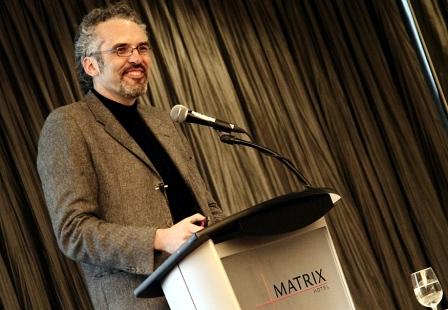ART: Let’s make this place as interesting as possible
 The difference between “world-class” peacocking and self-deprecation might be smaller than you think – going on about how great OR shitty Edmonton is happens around here with religious intensity and radio frequency. Both are often lazy and neither really solves any problems. But a change I’m enthused about is the evolution of honest discussion rising up through the middle of the polar camps, sometimes organized by committee, but often blooming in spontaneous conversation. More of us seem honestly interested in what we can do to make this place be as interesting as possible.
The difference between “world-class” peacocking and self-deprecation might be smaller than you think – going on about how great OR shitty Edmonton is happens around here with religious intensity and radio frequency. Both are often lazy and neither really solves any problems. But a change I’m enthused about is the evolution of honest discussion rising up through the middle of the polar camps, sometimes organized by committee, but often blooming in spontaneous conversation. More of us seem honestly interested in what we can do to make this place be as interesting as possible.
What’s helping this in part is our municipal politicians, who seem to have gone slightly insane with architectural ambition, especially in terms of replacing pre-existing cultural centres with new venues within walking distance of where they work and argue – the arena and the Royal Alberta Museum being two obvious examples.
But what I find more interesting than these developer sheet-soakers is the level of navigable public conversation, such as the sold-out Designing Downtown at the AGA a couple weeks back, and last night’s talk by Jeff Melanson in downtown’s Matrix Hotel, part of the Percolate speaker series. Melanson is executive director of Canada’s National Ballet School in Toronto – which he asked us not to hold against him – before getting into an hour-long talk about everything from the centuries-old tradition of arts patronage, to ways the walls between monolithic arts institutions and folk art (including graffiti and YouTube) not only are, but should be coming down. He used one example of his ballet-school entry decided solely on talent rather than money, and another about community outreach, where an initially politically-correct delving into troubled neighbourhoods by an institution ended up affecting its actual programming, bringing people from the streets onto the traditionally highfalutin’ stage.
Melanson is now Toronto Mayor Rob Ford’s arts advisor, and he brought up the fact that even in Canada there’s a real sense of there being “sports people” and “arts people,” and that such a distinction was a matter of programming, not necessity. As an artist with a five-year playoff beard, I appreciated this point.
Something I would raise here is in terms of institutions (to stay relevant) trying to capture the energy of YouTube – which Melanson pointed out gets another 24 hours of content every minute. Or, as he also noted, trying to ape the lure of reality TV. This tactic reminds me of the folly of individual newspapers trying to compete with the entire internet, sacrificing their budgets for the actual creation of news content for empty, digital glitz. Here, there’s always a danger of watering down expertise, which Melanson also brought up in terms of our education system, where the number of arts and music teachers compared to when you and I grew up has rather decreased. More often, teachers are generalists now, which helps fuel the idea arts are “something other people do.” We see the same thing at the opera, where it’s becoming hard to see a straight performance without some pop-culture twist, the equivalent of wearing a Bugs Bunny tie to your own wedding. It’s a tricky balance between distinction and acceptance.
I’m not saying institutions shouldn’t reach out – they sure should – I’m just arguing it’s important they hold their positions, consciously, as cultural and historical guardians. Believe me, I love all sorts of “low” culture – from “A Game of Thrones” to Batman comics to spray-painted protest on the No. 9. I would just say it’s more important for large institutions to effectively broadcast what they create and curate MORE than to try and adapt their content to the churning, trendy forms of an already over-saturated culture quite unable to stop spreading into the sewers.
Melanson seemed to be stressing this when he lamented the fact American and European opera and dance content is easily available online to watch, which Canada’s copyright laws, as he put, sometimes don’t allow us to experiment.
My favourite thing he brought up fused technology and the arts perfectly. Done in other cities, it’s a smartphone app downloadable free at the airport which links visitors to arts providers, giving them up-to-date information, distance from cultural locations, show info, operating hours and so on. If this isn’t in the works, it should be for us. Because it’s not just giant new venues that will bring Edmontonians together, but an immediate understanding of what we already have, right in front of our eyes.
***
Nancy Noble from the Museum of Vancouver speaks as part of Percolate May 19. Reserve your free ticket by clicking here.











